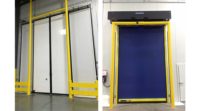Cold Energy Management: Doors with more

Jamison says recirculatory air doors are ideal in high-traffic doorways and can dramatically reduce moisture migration/infiltration from room to room.
Photo courtesy of Jamison Door Company
Photo courtesy of Jamison Door Company
Measure twice, cut once. This building basic – a reminder to think before you act – applies to so many aspects of food plant and warehouse construction. It also applies to energy savings when you consider cold doorway technologies.
There are many types of doors on the market and all claim to save you energy at a lower cost. However, it pays to partner with your cold facility designer and consider (1) how the door will be used, (2) how often and (3) the net opening required for a forklift, its load, and the mast to pass through – all without hitting the door.
If you want your cold food plant or warehouse to operate effectively, safely and efficiently (for energy savings), it’s important to review all your door alternatives, operating speeds, activation methods and to conduct a lifecycle cost analysis.

Rite-Hite says this impactable, high-speed insulated freezer door (separating a cooler and freezer) saves energy because of its fast cycle time. It does not rely on heat lamps to keep ice off of the curtain.
Photo courtesy of Rite-Hite Corp.
Photo courtesy of Rite-Hite Corp.
Opening options
Low-temperature doors range from traditional “hard” doors (filled with insulation and combined with an electromechanical operator) to sophisticated combinations of fast-operating flexible doors, “air curtains” and strip curtains. I will point out the energy-saving features of the most common doors, though this selection is purely objective and not intended to infer which door is best.Insulated “hard” horizontal sliding doors are prevalent in the industry. These doors resist heat and moisture infiltration because of their insulated cores, perimeter gaskets and relatively fast opening and closing speeds. Admittedly, these doors have heated gaskets that consume a small of energy. However, this cost is offset because the door system ultimately prevents ice build-up around the door (which would allow more moisture to enter the room).
Most hard, horizontal sliding doors now feature variable speed drives. These allow the door to open and close at a faster rate. These next-generation drives ramp the speed up but then slow down the door to prevent a jolt caused by quick starts and stops.
A new wrinkle in the market involves several “soft” sliding doors. They operate in a similar fashion but are made of flexible foam covered with a durable fabric. This provides the same energy savings as a traditional slider – except that the perimeter doesn’t generally provide as tight a seal. A soft door’s primary advantage is that it saves money in maintenance and repair costs if (rather, when) the door is hit.
How about a door that cannot be damaged? “Air curtains” used to refer to the small air blower mounted over a door to keep insects and heat from entering the opening. This technology has evolved into what we now call air “doors.”
One major benefit of an air door is that it uses air – sometimes heated and sometimes recirculated – to prevent heat and moisture infiltration into a cold room. In some applications, this means there is no other moving door for a lift operator to deal with and this results in faster room loading and unloading. In more extreme environments, operators also may employ a variety of fast-operating (bi-fold, fast rolling, impact) doors, which still clear the opening faster than a traditional sliding door.
A properly designed, and maintained air door will have a higher installed cost, but should have a relatively short payback due to energy savings, increased productivity, and safety (because there’s no floor ice build-up around the door).
Fast rolling doors can save energy on a high traffic opening by drastically decreasing the time the door is open. These doors can open at more than 8 feet per second and can include radiant or perimeter heaters to prevent ice formation. They also may be used with a hard door – particularly in areas or times (weekends, nights) where there’s little product transfer activity. I know of at least one fast roll-up door supplier that provides an insulated core to provide additional insulation when the door is in the closed position.
Last but not least, many facility operators have long relied on strip curtains in high traffic openings. Made of a clear vinyl-type material, these doors use overlapping strips to block the flow of heat and air when a load passes through them. Then, they simply reclose behind the load’s passing. Operators most often install strip curtains in conjunction with a hard door, which also may be closed when traffic stops. In spaces where they separate rooms of similar temperatures, strip curtains may be the only opening protection required.

Rytec says its Fast-Fold Pneumatic cooler door is powered by standard shop air – making it energy efficient and easy to maintain. The door opens at speeds of 72 inches per second and comes with an optional stainless steel package for food processing environments.
Photo courtesy of Rytec Corporation
Photo courtesy of Rytec Corporation
Don't forget the dock!
Dock doors can be one of the largest energy hogs. Of course, energy savings begins with a dock manager who must be vigilant and enforce the rules (don’t open dock door until trailer is securely backed against dock seals, close dock door before departing dock, etc.) Even so, there are other ways heat and moisture can enter around a dock opening.Pit-type dock levelers have huge voids underneath that can allow warm air to enter the building – even when the board is insulated and it has gaskets around the perimeter. Once a door’s bottom panel is damaged, it will no longer seal properly. Budget constraints sometimes dictate the use of thinner, sectional insulated doors with the belief that they will be sufficient.
A well-designed dock opening – especially those for low-temp docks – will have a single-piece, insulated, gasketed vertical lift door, specifically designed for cold storage use. Operators can drastically reduce damage if they combine a vertical lift dock door with a vertical storing leveler. This better ensures that the door can seal against the concrete floor of the leveler pit and create a tight seal all around. Even so, the door must be properly adjusted and maintained so that it clears the top of the opening to prevent being hit by a tall load going into or out of the trailer.
Bob Hunt is an architectural engineer and project principal with The Haskell Company, Jacksonville, Fla. A 35-year industry veteran, Hunt also is 2010-11 chairman of the International Association for Cold Storage Construction (IACSC). Readers may contact him at Robert.hunt@haskell.com.
Minds over matter
Drive improvement with forklift operators' doorway insights, observations.Any door will save you energy, but there is one condition: It must be used properly. We can put all the automatic opening and closing features on a door – but a determined forklift operator can find a way to circumvent them.
For starters, it’s important that facility owners better understand their forklift drivers’ activities and routines as well as their concerns.
A driver may leave the door open because he or she doesn’t want to feel “trapped” in a closed room. It could be that he feels the door speed slows him down. Alternatively, a driver may leave the door open because he just has to go get one pallet – only to find that he can only reach it by rearranging several other pallets.
No matter the reason, open doors can lead to a build-up of snow, frost and/or ice around the doorway. Not only is this a safety hazard but it also drastically increases your monthly energy bill. I believe that every operator should see a copy of your monthly utility bill. This may make them more aware of the consequences of poor door management.
Looking for a reprint of this article?
From high-res PDFs to custom plaques, order your copy today!






